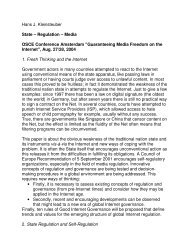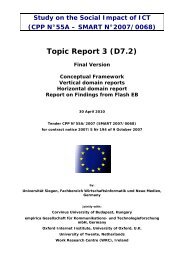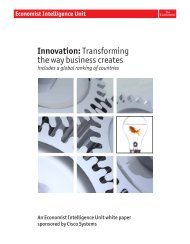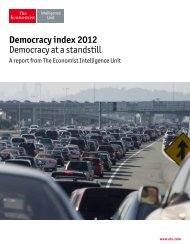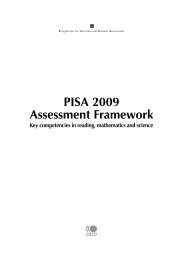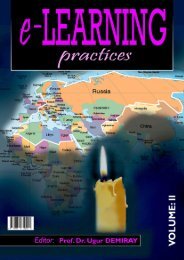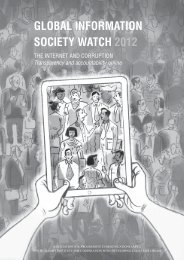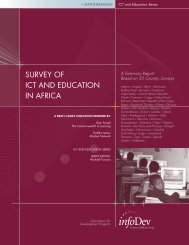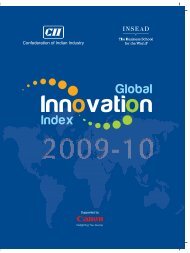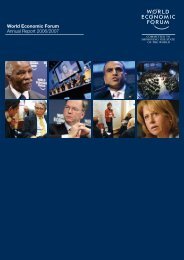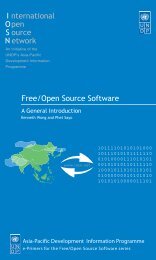You also want an ePaper? Increase the reach of your titles
YUMPU automatically turns print PDFs into web optimized ePapers that Google loves.
8 ❘ FREE/OPEN SOURCE SOFTWARE: LOCALIZATIONThe TIS-620 code table was pushed for inclusion in the Unicode table. Although the influence of the ISCIIencoding scheme (which forced all vowels, including the leading vowels, to always be encoded afterconsonants) had made the Unicode consortium force Thai to change its encoding scheme, TISI defendedthe TIS-620 practice, as Thai script did not need such complications. Although this made Thai (and Lao)different from other Indic scripts, it saved Thai (and possibly Lao) implementations from the big hindranceof lacking supporting technology for ISCII practice at that time, as well as from the burdens of migrationfrom the well-settled and widely-adopted practice. So all Thai language-processing codes for TIS-620and Unicode, apart from the necessary code conversion, are fully compatible.In addition to the character set, the Thai keyboard layout was standardized as TIS 820-2531 in 1988, andlater amended by adding keys for special symbols and published again as TIS 820-2538 in 1995. Anotherkeyboard variant designed after research on character frequencies, called Pattajoti, is also available. Butit is not as popular and is not a national standard.Thai input/output methods were also standardized through the efforts of the Thai API Consortium (TAPIC),which was formed by a group of vendors and academies and sponsored by the National Electronics andComputer Technology Center (NECTEC). The specification, called WTT 2.0 (from its Thai abbreviation‘Wor Tor Tor’, which stands for “Wing Took Tee” or “runs everywhere”), was published in 1991. Its contentswere composed of three parts, describing character set and encoding scheme, input/output methods,and printer identification numbers.Although not endorsed by TISI as a national standard, WTT 2.0 was adopted by virtually all the majorvendors who participated in the draft, including DEC, Sun, Microsoft, MacIntosh and IBM. WTT 2.0 hadenjoyed being the de facto national standard for seven years, until it was dubbed TIS 1566-2541 by TISI in1998.There are other activities 6with international standards bodies that promote understanding of Thailanguage requirements among vendors. For example, in 1998 the “tis-620” MIME character set wasregistered with the Internet Assigned Number Authority (IANA) for information interchange on theInternet. 7 Another example is an annex of ISO/IEC 14651, International String Ordering, describing howthe predefined sorting order for Unicode can be tailored to match the requirements of Thai string ordering.With these established standards, specifications for Thai implementations are clear and interoperabilityis guaranteed. The standards have played an important role in several developments in the Thai computerindustry, including FOSS localization.LocalizationThai localization of FOSS was started in 1993 by Thai students in Japan with the ThaiTeX project initiatedby Manop Wongsaisuwan as a first effort to use Thai in the versatile typesetting program. 8 Subsequently,the project was maintained by the Thai Linux Working Group (TLWG) 9 which was formed in 1999.Apart from Thai LaTeX, other surrounding UNIX environments have been modified by the same group ofpeople to support Thai. Their work may be summarized as follows:Manop Wongsaisuwan: ThaiTeX (ttex), X bit-map fonts.Thai Project (by Vuthichai Ampornaramveth): 10 cttex (C version of ttex), xiterm+thai (Thai X terminal),likit (Thai text editor for X).ZzzThai project (led by Poonlap Veerathanabutr): 11 thailatex-component, X bit-map fonts, Thaisupport in xfig, Thai-HOWTO and Thai RPMs.At the same time, other Thai support projects were developed by researchers of the NECTEC in Thailand,including:Virach Sornlertlamvanich: Thai support in Omega (Unicode-based TeX kernel), Thai in GNU. Emacs,machine translation, and many other NLP projects.6Karoonboonyanan, T. and Koanantakool T., Standardization Activities and Open Source Movements in Thailand, Country Report, MLIT-4,Myanmar; also available at www.nectec.or.th/it-standards/mlit99/mlit99-country.html.7Tantsetthi, T., ‘Campaign for Internet-Standard-Conforming Thai Usage’; available from software.thai.net/tis-620.8Wongsaisuwan, M., ‘Introduction to ThaiTeX’; available from thaigate.nii.ac.jp/files/thaitex.pdf.9Thai Linux Working Group, ‘Thai LaTeX’; available from inux.thai.net/plone/TLWG/thailatex.10Ampornaramveth, V., ‘NACSIS R&D Thai Project Page’; available from thaigate.nii.ac.jp.11eucthai, ‘ZzzThai Project’; available from www.fedu.uec.ac.jp/ZzzThai/.



